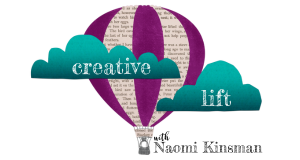When we don’t leave room in our plans, we squash the possibility of surprise. What’s worse, we often don’t realize we’re limiting ourselves.
Picture two actors onstage, beginning an improvised scene.
Actor One: (pointing frantically) Oh no, look, it’s a Tyrannosaurus Rex.
Actor Two: (leaning forward) And look, he’s nodding at us. I think he’s trying to tell us something.
Actor One: He’s running straight toward us! Run!
Actor Two: (running along behind Actor One, looking over her shoulder) I wonder if we should try to talk to him?
Actor One: He’s a monster. AGGGGH! Run!
Actor Two can’t salvage the scene, and ends up running offstage with Actor One. The scene is over.
In improv, we call this scenario “saying no.”
Actor One began the scene planning for a T-Rex to chase her offstage. No matter what her scene partner said, Actor One insisted the scene go as she planned. She said no to all the options and possible surprises Actor Two introduced.
Why might this happen?
Actor One might be feeling nervous. The audience is watching, and the silence is lengthening. So, she blurts out the first thing that comes to mind. There’s a T-Rex! Good! Drama. Danger. The silence is broken. But Actor Two, relieved of the burden of introducing the first idea, sees the dead-end problem in the scene. Two actors shrieking and running away isn’t really a scene. So, Actor Two introduces the possibility that this T-Rex isn’t like other dinosaurs. If Actor One allows this new idea to develop, something interesting might happen. Neither actor is responsible entirely for the success of the scene. Both actors are likely to be surprised. When actors are bold enough to say yes to the unknown, interesting things can happen.
Often, we say no in our real lives, too.
- We have a firm agenda for a meeting or class and refuse to be sidetracked, even when interesting opportunities for learning or exploration arise.
- We mentally script a conversation or confrontation and don’t leave room to listen and respond in real time.
- We schedule our days to their very edges and don’t leave room for serendipitous detours.
Unfortunately, the solution isn’t as easy as throwing plans out the window. Classes, confrontations, and even day-to-day schedules suffer if we don’t prepare at all. Maybe here, we can learn a thing or two from improvisational actors.
- First, improv actors know that improvisation is a skill to be practiced and refined. It’s not a “who cares, I don’t need a script” attitude. Rather, improv actors shift their focus from practicing for ONE predictable scenario into practicing for a MULTITUDE of scenarios. They practice listening, saying yes, and adding ideas to move the game forward.
- Second, improv actors know that every scene is an experiment. Some will work better than others, and some will completely fail. They accept the failures as part of the learning process.
- Third, improv actors build possibilities in the spaces between people, rather than limiting the options to their own experience, ideas and skill set. They aren’t afraid to collaborate and to allow others to help.
Recently, I’ve been challenged to take steps forward into new territory–artistically, professionally, and personally. What’s fascinating is how pertinent my improv training continues to be, no matter how far the challenge is from an actual stage. It turns out that improvisation can be a training ground for real life. As in on-stage improv, when you approach life’s situations with an open-for-surprise attitude, delightful things can happen.
I wonder: In what life situation might you practice the art of improvisation? I hope you try it, and if you do, share your story on Instagram or Twitter and tag me. I’d love to hear how the experiment goes for you.

